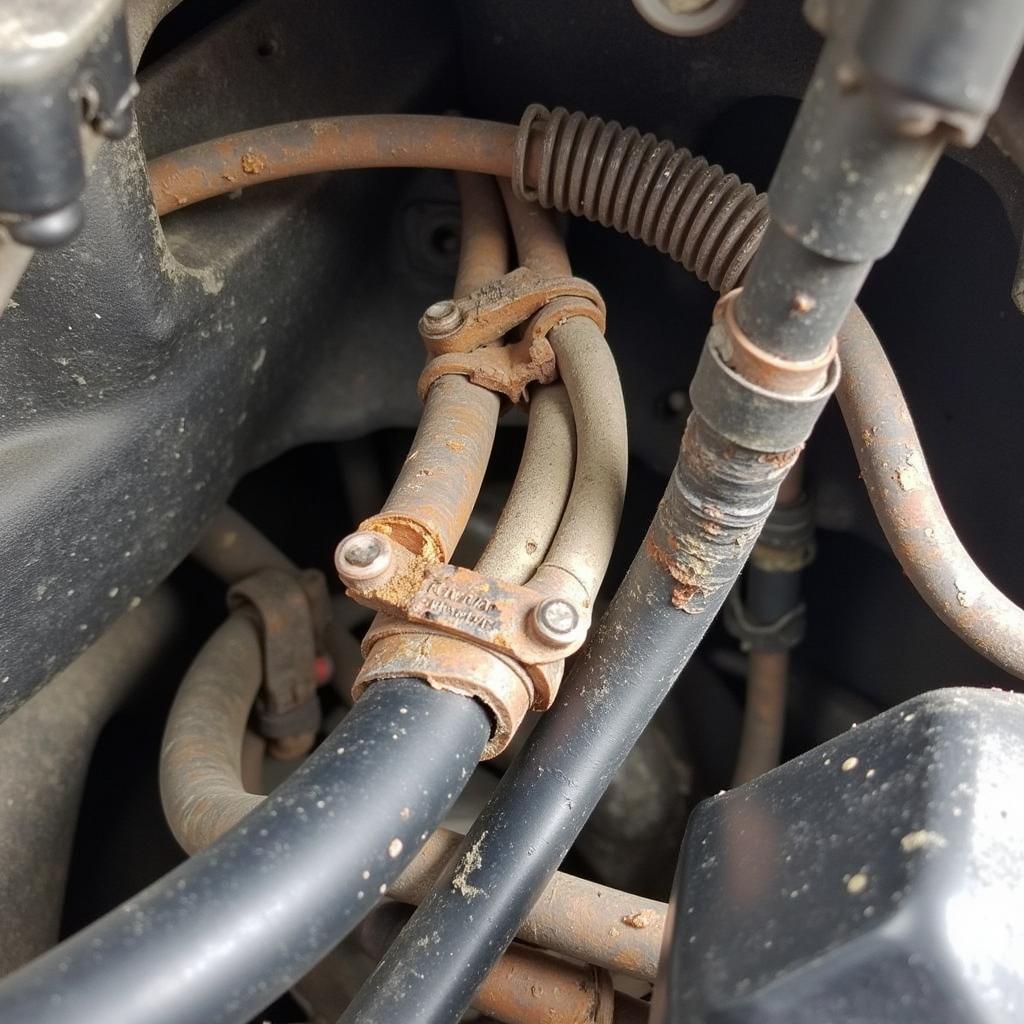The AdBlue warning light on your VW Sharan is a common issue that can be quite alarming. It signifies a problem with the AdBlue system, which is essential for reducing harmful emissions. In this guide, we’ll dive into the potential causes of this warning light, understand its significance, and explore how to address it effectively. We’ll also touch upon how to reset the warning light once the issue has been resolved.
Understanding the AdBlue System and its Importance
AdBlue is a urea-based solution that plays a crucial role in reducing harmful nitrogen oxide (NOx) emissions from diesel engines. When injected into the exhaust system, AdBlue reacts with NOx, converting it into harmless nitrogen and water.
The AdBlue system in your VW Sharan includes a tank, a sensor, a dosing module, and a control unit. These components work together to ensure the proper delivery of AdBlue to the exhaust system.
Common Reasons for the AdBlue Warning Light
Several factors can trigger the AdBlue warning light on your VW Sharan. The most common ones include:
1. Low AdBlue Fluid Level
The most frequent cause is simply running low on AdBlue fluid. This can happen due to neglecting regular refills or encountering heavy driving conditions that consume AdBlue at a faster rate.
2. AdBlue Sensor Malfunction
The AdBlue sensor monitors the fluid level and quality. If the sensor malfunctions, it might provide inaccurate readings, triggering the warning light even if there’s enough AdBlue.
3. AdBlue Dosing Module Issues
The dosing module is responsible for injecting the correct amount of AdBlue into the exhaust. A faulty dosing module can lead to improper AdBlue delivery, causing the warning light to illuminate.
4. AdBlue Tank Problems
The AdBlue tank can sometimes experience issues like leaks, blockages, or damage, leading to an inadequate supply of fluid.
5. AdBlue Control Unit Errors
The control unit manages the entire AdBlue system. If the control unit malfunctions, it can trigger the warning light due to incorrect calculations or faulty commands.
Resolving the AdBlue Warning Light: Step-by-Step Guide
Here’s a systematic approach to resolving the AdBlue warning light:
-
Check the AdBlue Fluid Level: Begin by checking the AdBlue tank level using the gauge on the dashboard or the tank’s dipstick. If the level is low, refill the tank with AdBlue fluid.
-
Verify AdBlue Quality: Ensure you’re using genuine AdBlue solution from a reputable source. Contaminated AdBlue can damage the system.
-
Check for Leaks: Inspect the AdBlue tank, hoses, and connections for any leaks. If you find a leak, repair it promptly.
-
Inspect the AdBlue Sensor: The sensor might be dirty or malfunctioning. Carefully clean it with a clean cloth or consult a mechanic to replace it if necessary.
-
Examine the Dosing Module: Inspect the dosing module for any damage or obstructions. If it appears faulty, have it replaced by a qualified mechanic.
-
Consider the AdBlue Control Unit: If the warning light persists despite addressing the other issues, the control unit might be faulty. Consult a mechanic to diagnose and repair the control unit.
Resetting the AdBlue Warning Light
Once you’ve successfully addressed the AdBlue issue, you’ll need to reset the warning light. Here’s how:
-
Turn the ignition key to the “on” position without starting the engine.
-
Press and hold the “OK” button on the steering wheel until the AdBlue warning light blinks once.
-
Release the “OK” button.
-
Turn the ignition key to the “off” position.
The AdBlue warning light should now be reset. If it doesn’t, consult a mechanic for further assistance.
Expert Insights from [Expert Name], Certified Automotive Technician
“It’s important to address the AdBlue warning light promptly,” says [Expert Name], a certified automotive technician with over 15 years of experience. “[Expert Name] continues, “Ignoring it can lead to more serious engine problems and potentially expensive repairs.”
“[Expert Name] adds, “If you’re unsure about the cause of the AdBlue warning light, it’s always best to seek professional diagnosis and repair from a qualified mechanic.”
Frequently Asked Questions about the AdBlue Warning Light
Q: What happens if I keep driving with the AdBlue warning light on?
A: Continuing to drive with the AdBlue warning light on can eventually lead to the engine going into limp mode, restricting your vehicle’s performance and potentially causing further damage.
Q: Can I use regular diesel fluid in my AdBlue tank?
A: No. Regular diesel fuel is not compatible with the AdBlue system and can severely damage it. Always use genuine AdBlue fluid.
Q: How often should I refill the AdBlue tank?
A: The AdBlue tank’s capacity and consumption rate vary depending on your vehicle and driving habits. Generally, you’ll need to refill it every 5,000-10,000 miles.
Q: Can I reset the AdBlue warning light myself?
A: You can generally reset the warning light after addressing the underlying issue. However, if you’re unsure about the cause or the resetting process, it’s advisable to seek professional assistance.
Q: Is there a way to permanently disable the AdBlue system?
A: While some individuals might consider disabling the AdBlue system, it’s not recommended. The system is designed to reduce harmful emissions and can lead to legal issues or vehicle performance problems if deactivated.
By understanding the potential causes of the AdBlue warning light and following the steps outlined above, you can effectively address the issue and prevent further complications. Remember to always prioritize the use of genuine AdBlue fluid and consult a qualified mechanic if you encounter any difficulties.


